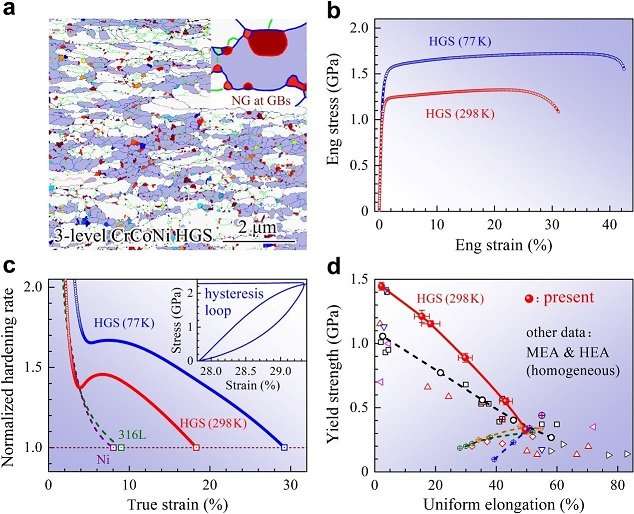Researchers present new strategy for extending ductility in a single-phase alloy

Simultaneous high strength and large ductility are always desirable for metallic materials. However, while the strength of metals and alloys can be easily increased by five to 15 times through simple plastic deformation or grain refinement down to the nano-scale, the gain in strength is usually accompanied by a drastic loss of uniform ductility. Ductility depends strongly on the work hardening ability, which becomes weak in materials with high strength, especially in a single-phase material.
Publishing online in PNAS, the research group of Prof. WU Xiaolei at the Chinese Academy of Sciences, in collaboration with Prof. En Ma at Johns Hopkins University, U.S., have demonstrated a strategy for exploiting a dynamically reinforced multilevel heterogeneous grain structure (HGS). They demonstrated the behavior of such an HGS using the face-centered-cubic CrCoNi medium-entropy alloy (MEA) as a model system.
Back stress hardening is usually not obvious in single-phase homogeneous grains. To overcome this, the scientists purposely created an unusually heterogeneous grain structure. They took advantage of the low stacking fault energy of the MEA, which facilitates the generation of twinned nano-grains and stacking faults during tensile straining, dynamically reinforcing the heterogeneity on the fly.
For the resultant extreme HGS, back stress hardening can be made unusually strong and sustained to large tensile strains after yielding at gigapascal stress in the absence of heterogeneities from any second phase. Specifically, using cold rolling and recrystallization annealing, the researchers skillfully constructed an HGS with three-level grain sizes (micrometer, submicron, and nanometer), across which stress and strain partitioning occur when the HGS is plastically deformed.
New nano-grains form at grain corners due to the larger stresses there. This dynamic grain refinement, similar to the TWIP effect and the TRIP effect, contributes to the back stress hardening, which is found to be the largest in all the alloys reported so far.
This HGS achieves in a single-phase, simple-structured (FCC) alloy a strength-ductility combination that would normally require complex heterogeneities such as in multi-phase steels.
More information: Muxin Yang et al, Dynamically reinforced heterogeneous grain structure prolongs ductility in a medium-entropy alloy with gigapascal yield strength, Proceedings of the National Academy of Sciences (2018).
Journal information: Proceedings of the National Academy of Sciences
Provided by Chinese Academy of Sciences




















